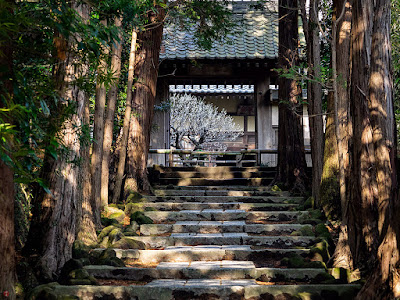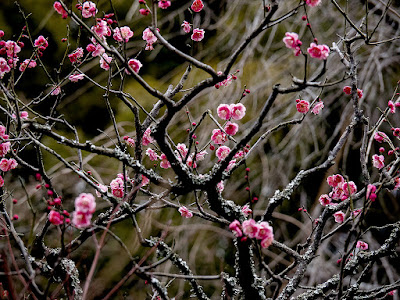My photographic notes about the four seasons in Kamakura or the gardens of Zen
March 29, 2019
Haku-mokuren (Magnolia heptapeta) flowers: Engaku-ji
As spring blooms into full glory, the bright sunlight reaching the ground increases more and more. In concert with this deepening of springtime, every living thing, which starved for the glaring sunlight in its winter sleep, rapidly regains its true life force for regrowth.
As if to suddenly release the rich vigor saved in quiet winter, various kinds of young leaves and colorful flowers instantly appear in the lively gardens which are full of the gentle warm sunlight.
A cascade of silky Haku-mokuren flowers are blooming radiantly in the deep blue sky like the white lotus flowers ascending high into the air, which gives me heartfelt joy of spring this year also.
Stone image of Jizo-bosatsu: Tokei-ji
A tiny stone image of Jizo Bosatsu (Jizo Bodhisattva), that looks like an innocent infant smiling benevolently, is enshrined quietly in the shallow hollow on the thickly moss-covered rock-face.
The young leaves of Iwa-tabako (Conandron ramondioides) have just come out from the narrow cracks in the stone-wall and are surrounding this small avatar of Buddha as if to offer up spring prayers.
Jizo Bosatsu reveals the Buddha's salvation for the lost souls cast into Hell and is also widely accepted as a guardian deity of children in folk beliefs in Japan.
Kawazu-zakura (Japanese cherry) flowers: Engaku-ji
In accord with the earth's revolution and rotation, living organisms keep cycling the sequence of their lives.
The flowers of each season bloom beautifully and fade away quietly by their own private nature.
The cherry blossoms are silently blooming above me without unveiling their secret stories and histories. Although I rejoin them every spring, I know nothing about them but their curious given-name and touching beauty.
March 3, 2019
White ume (Prunus mume) flowers: Kaizo-ji
The dominance of the wintry coldness has already become weaker and weaker. In response to the coming back of the fresh spring sunlight, various living things in this garden have begun awaking out of their winter quiescence one after another.
In the gentle spring sun, the white scented flowers of Ume are gloriously blooming in unison while vigorously emitting their pleasant aroma into the air, which makes me have a fantasy that the numerous flower-fairies of this garden are secretly dancing for joy at the long-awaited arrival of spring.
Stone image of Jizo-bosatsu: Jochi-ji
As spring advances gradually, the sun ascends into the sky at a higher altitude.
The bright sunbeams shining through the leaves of the trees reach these hollows in the rock, where the small stone-images of Kannon Bosatsu are enshrined in perfect tranquility.
The trees and plants have steadily resumed their inconspicuous regrowth and are giving off the pleasant fragrance of life force into the quiet air surrounding me.
White Ume (Prunus mume) flowers: Engaku-ji
The perpetual revolution of the earth around the sun causes the continuous change of the solar energy reaching the surface of the earth. The seasons and the seasonal scenery are ceaselessly rotating based on this orbital revolution.
Every living thing proceeds with its cycle of birth, death and rebirth, while synchronizing with this eternal rotation.
In the beautiful spring gradually awakening in front of me, the birds have just broken the silence and begun singing their lively songs again in the trees to rejoice over the return of spring.
Baika-ouren (Coptis quinquefolia) flowers: Tokei-ji
In a shady corner of the garden, I found the very small flowers (about 1.5 cm in diameter) of Baika-ouren secretly blooming on their stalks which stick out from the wet ground thickly covered with dead leaves.
What looks like the white petal of this small flower is actually its sepal and the true form of the flower is its tiny spoon-shaped yellow potion.
Subscribe to:
Posts (Atom)






















